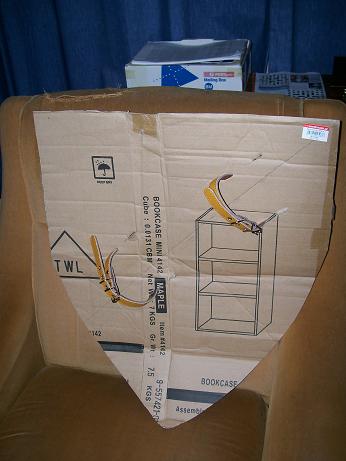I personally prefer a center boss shield for larping, which doesn’t have straps. It has a handle and a boss. They’re slightly more work, but I think they’re worth it.
However, if you want to make one with straps, they’re easy enough…

I prefer a heater about 600mm x 600mm, and I use it rotationally for blocking my legs. This means that instead of lowering the bottom corner, I rotate my arm, like a karate block, and use the corner that has my fist behind it to block. Most people don’t block like this, they just hang the shield in front of them like an pizza advertising sign. But it works for me  It’sa very natural way to use a shield, all you have to do is try to move your fist into the oncoming weapon and the shield works.
It’sa very natural way to use a shield, all you have to do is try to move your fist into the oncoming weapon and the shield works.
I’ve marked a diagonal line on the shield, which represents the center of balance if hung from the corner. I like to put my arm along this line, because it gives the shield a very neutral balance. I see other people who strap their shields with 1/3 of the mass above their arms and 2/3 below and I hate using them. Again, this is a personal thing, but if you’re asking how to strap a shield, you probably don’t have a strong preference, so I recommend you do it my way.
I tip the angle of the strap for the hand slightly forward, for comfort.
Pretty much anything will do for strapping. An old belt or strips of leather are preferred. I like to use 3-4 layers of corflute. Always put the ugly advertising inwards, so you have a pretty white surface on both faces of the shield.
Glue all but the last layer of corflute together. cut slots through the sheets and poke your straps through. I like to have buckles on the outside, so you can adjust the tightness of the straps. This’ll allow you to get them nice and snug, which gives good control, wearing either nothing on the arm or armour.
Glue the other (front) face on.
Clean up all the edges with a craft knift.
Run heavy duct or gaffa tape arounnd the edges to keep them all together
Glue light fabric over the front of the shield, wrapping over the edge and onto the back of the shield. This gives you a nice surface to paint and it also stops the shields chewing up peoples nice weapons.
Then paint it, because paint hides all our sins and makes the shield look fantastic. 

 It’sa very natural way to use a shield, all you have to do is try to move your fist into the oncoming weapon and the shield works.
It’sa very natural way to use a shield, all you have to do is try to move your fist into the oncoming weapon and the shield works.
 That’s how I get it to go 'round curves.
That’s how I get it to go 'round curves.
